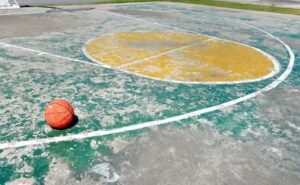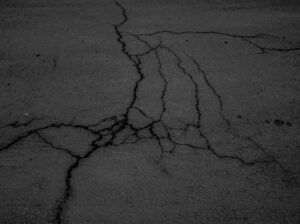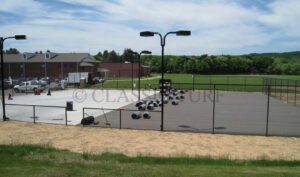 Outdoor athletic courts take quite a beating over time. Whether it’s from all the people’s feet using them or the harsh weather hitting them time and time again, eventually old courts wear out. What are some warning signs you need a new athletic court?
Outdoor athletic courts take quite a beating over time. Whether it’s from all the people’s feet using them or the harsh weather hitting them time and time again, eventually old courts wear out. What are some warning signs you need a new athletic court?
Signs You Need a New Athletic Court
First, have the colors faded? If so, that indicates the court is older rather than newer. This is true if you see rust spots as well.
Next, do you notice any surface cracks, such as hairline cracks or raveling?
Hairline cracks are small, irregular cracks present over large areas of the court. If left untreated, they will develop into more serious cracks.
Raveling involves asphalt disintegration resulting in loose debris on the pavement. You’re also likely to notice a roughness to the pavement that wasn’t there before, as well as water collecting in the raveled locations on the court. Water on the court can make people skid, fall down, and hurt themselves– you don’t want to regularly use a court that’s covered in water, that’s for sure!
Other types of surface cracks to look for include alligator “interlocking” cracks, which form a pattern over the surface of the court looking like an alligator hide, as well as shrinkage/stress cracks, which tend to be small, random, interconnected cracks featuring irregular angles and sharp corners.
 Speaking of cracks, when they go all the way through several inches of asphalt they’re known as pavement cracks. Be on the lookout for structural cracks that start out thin but grow wide with age if not fixed. Check the corner of the concrete net-post footings for radial cracks. If there has been an asphalt overlay done to the court, you might see reflection cracks, which mirror the crack pattern below in the old pavement surface underneath the overlay. Then there are heat-checking cracks which were caused during compaction of the asphalt– in this case the roller stretched the asphalt horizontally and overdid it, resulting in heat-checking cracks.
Speaking of cracks, when they go all the way through several inches of asphalt they’re known as pavement cracks. Be on the lookout for structural cracks that start out thin but grow wide with age if not fixed. Check the corner of the concrete net-post footings for radial cracks. If there has been an asphalt overlay done to the court, you might see reflection cracks, which mirror the crack pattern below in the old pavement surface underneath the overlay. Then there are heat-checking cracks which were caused during compaction of the asphalt– in this case the roller stretched the asphalt horizontally and overdid it, resulting in heat-checking cracks.
Concrete surfaces can show signs of the aforementioned raveling, as well as peeling and bubbles. If you notice any dents, divots or depressions in the court, it might be time for a new one.
Oftentimes time and weather conspire together to wreak havoc on outdoor athletic courts. General asphalt, in particular, expands and contracts in response to the weather temperatures, and over time it’s likely that cracks will occur thanks to those heating and cooling movements.
We also have to remember that the ground underneath a court is not static. It may move causing a gap in the foundation and the court may sink. If you see curvature in the asphalt, or the court surface is no longer flat as intended, it’s time to think about replacing the court.
Schools, community centers/municipalities, and private owners who want to enjoy outdoor athletic courts often come to the conclusion that their old courts need to be replaced because they have too many cracks, uneven surfaces, less traction than needed, standing pools of water on them, and other problems that warrant starting over.
Logically, when faced with the idea of a new court, one asks themselves, “Now who is going to do the work and what do I/we want this time around?”
The Benefits of Post-Tension Concrete Surfaces
 Classic Turf Company has years of experience with tennis courts, basketball courts, and other courts. Furthermore, as a company located in the Northeast, known for its cold, winter weather, Classic Turf has come up with courts that smartly handle weather changes so they don’t easily crack! Known as “post tension concrete technology,” the courts from Classic Turf are designed in such a way that Classic Turf offers a 20-year crack-free guarantee. Without getting too technical, the smart technology reduces and eliminates control joints while pre-stressing the steel tendons, inducing compression into the concrete. This way of doing things gives the stuff underneath the playing surface the necessary “give” to handle nature’s temperature changes and ground movements well. If you’ve heard of the term “slack,” post tension concrete technology essentially gives the court foundation slack, and that’s a good thing.
Classic Turf Company has years of experience with tennis courts, basketball courts, and other courts. Furthermore, as a company located in the Northeast, known for its cold, winter weather, Classic Turf has come up with courts that smartly handle weather changes so they don’t easily crack! Known as “post tension concrete technology,” the courts from Classic Turf are designed in such a way that Classic Turf offers a 20-year crack-free guarantee. Without getting too technical, the smart technology reduces and eliminates control joints while pre-stressing the steel tendons, inducing compression into the concrete. This way of doing things gives the stuff underneath the playing surface the necessary “give” to handle nature’s temperature changes and ground movements well. If you’ve heard of the term “slack,” post tension concrete technology essentially gives the court foundation slack, and that’s a good thing.
Sure, you could go with asphalt for your new court, but you’re going to need to make costly repairs to it in a couple year’s time because that’s the nature of the beast. However, if you’re the type of person who wants a solid, durable, long-lasting surface you don’t have to worry about for the next 20 years, then Classic Turf’s post tension concrete court offerings are the way to go.
To find out more about Classic Turf Company’s post tension concrete athletic courts, please call 1-800-246-7951 today.
